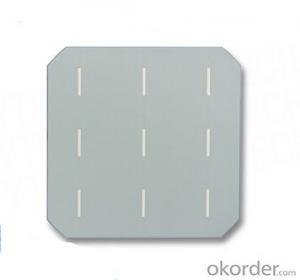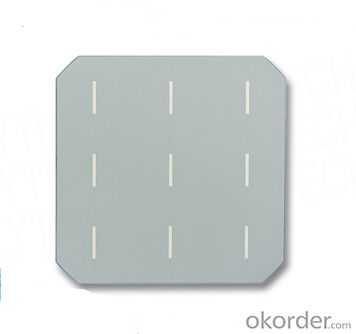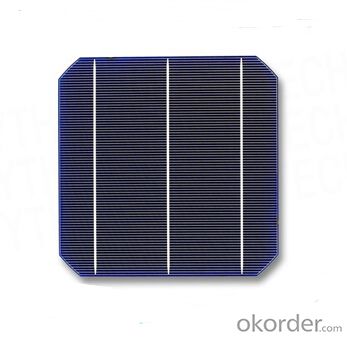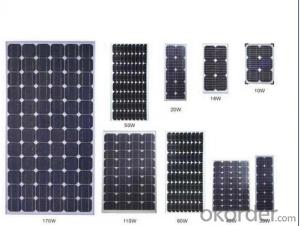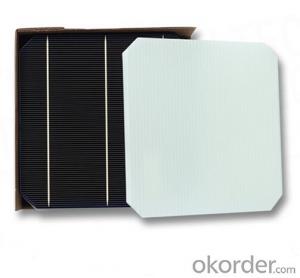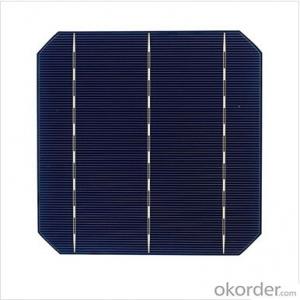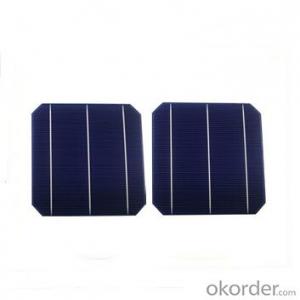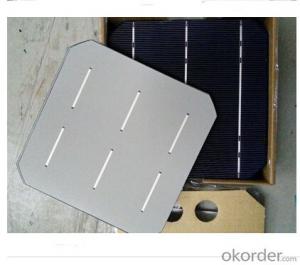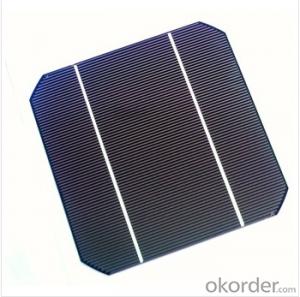India Solar Cells - Monocrystalline Solar Cells A Grade -17.8%
- Loading Port:
- Shanghai
- Payment Terms:
- TT OR LC
- Min Order Qty:
- 5000 pc
- Supply Capability:
- 8000000 pc/month
OKorder Service Pledge
OKorder Financial Service
You Might Also Like
Brief Introduction of Solar Cells
Solar cells is made by solar wafer, it has three categories of solar cell right now, monocrystalline polycrystalline and thin film,These cells are entirely based around the concept of ap-n junction, which is the critical part of solar module, it is the part that can convert the light energy into electricity, the thickness is from 180um to 200um, with even busbars to conduct electricity, textured cell can decrease diffuse reflection; they are often electrically connected and encapsulated as a module. Photovoltaic modules often have a sheet of glass on the front (sun up) side, allowing light to pass while protecting semiconductor wafers from abrasion and impact due to wind-driven debris, rain, hail, etc. Solar cells are also usually connected in series in modules, creating an additive voltage. Connecting cells in parallel will yield a higher current;With high quality and stable quality. Our Cells can greatly improve the performance of Solar Modules.
Advantage of Monocrystalline Solar Cells
• High efficiency and stable performance in photovoltaic conversion.
• Advanced diffusion technique ensuring the homogeneity of energy conversion efficiency of the cell.
• Advanced PECVD film forming, providing a dark blue silicon nitride anti-reflection film of homogenous color and attractive appearance.
• High quality metal paste for back surface and electrode, ensuring good conductivity, high pulling strength and ease of soldering.
• High precision patterning using screen printing, ensuring accurate busbar location for ease with automatic soldering a laser cutting.
Specifications of Monocrystalline Solar Cells
Format : 156 mm × 156 mm ± 0.5 mm
Thickness: 210 μm ±40 μm
Front (-) : 1.5mm bus bars (silver),blue anti-reflection coating (silicon nitride)
Back (+) : 2.5mm wide soldering pads (silver) back surface field (aluminium)
Efficiency (%) Pmpp (W) Umpp (V) Impp (A) Uoc (V) Isc (A) |
18.20% 4.43 0.536 8.263 0.634 8.712 |
18.00% 4.38 0.535 - 8.188 0.633 8.701 |
17.80% - 4.33 0.534 - -8.112 ---0.632 ----8.652 |
17.60% 4.28 0.533 8.036 0.631 8.641 |
17.40% 4.23 0.529 8.005 0.630 8.591 |
17.20% 4.19 0.525 7.973 0.627 8.542 |
17.00% 4.14 0.522 7.926 0.624 8.495 |
16.80% 4.09 0.518 7.893 0.620 8.452 |
16.60% 4.04 0.515 7.844 0.617 8.410 |
16.40% 3.99 0.514 7.765 0.616 8.373 |
16.20% 3.94 0.511 7.715 0.615 8.317 |
16.00% 3.89 0.509 7.650 0.613 8.251 |
Usage of Monocrystalline Solar Cells
Solar cells are often electrically connected and encapsulated as a module. Photovoltaic modules often have a sheet of glass on the front (sun up) side, allowing light to pass while protecting the semiconductor wafers from abrasion and impact due to wind-driven debris, rain, hail, etc. Solar cells are also usually connected in series in modules, creating an additive voltage. Connecting cells in parallel will yield a higher current; our solar cells have passed IEC Certification. With high and stable quality, our cells can greatly improve the performance of Solar Modules.
Packaging & Delivery of Monocrystalline Solar Cells
Carton Box Package and Deliver by air. It should be noticed that it should be avoid of water, sunshine and moist.


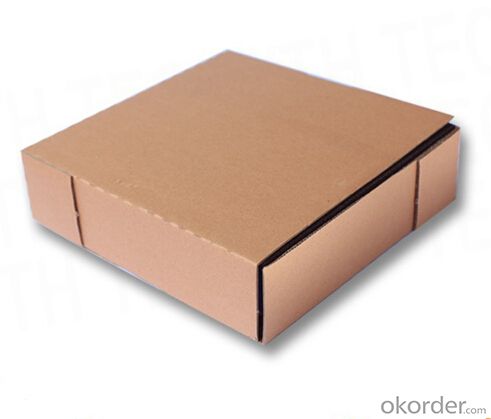
FAQ
We have organized several common questions for our clients,may help you sincerely:
①What price for each watt?
It depends on the efficiency of the solar cell, quantity, delivery date and payment terms.
②How long can we receive the product after purchase?
In the purchase of product within three working days, We will arrange the factory delivery as soon as possible. The pecific time of receiving is related to the state and position of customers.Commonly 7 to 10 working days can be served.
③Can you provide the peripheral products of the solar panels, such as the battery, controller, and inverter? If so, can you tell me how do they match each other?
Yes, we can, we have two companies for solar region, one is CNBM International, the other is CNBM engineering Co.
We can provide you not only the solar module but also the off grid solar system, we can also provide you service with on grid plant.
④What is your warranty of solar cell?
Our product can promise lower than 0.3% open box crack, we support claim after opening the box if it has crackm color difference or sth, the buyer should give pictures immediately, we can not accept the claim after the solar cell has assembled to solar panel.
• Timeliness of delivery
• ⑤How do you pack your products?
We have rich experience on how to pack the solar cell to make sure the safety on shipment, we could use wooden box or pallet as buyer's preference.
⑥ Can you do OEM for us?
Yes, we can.
- Q: What can be used as the materials for solar cells?
- The thin-film absorbers
- Q: Can solar cells be used in aircraft applications?
- Yes, solar cells can be used in aircraft applications. They are commonly used in solar-powered aircraft to convert sunlight into electrical energy, which can then be used to power the aircraft's systems and/or charge its batteries. Solar cells can help reduce the reliance on fossil fuels, increase flight time, and contribute to more sustainable aviation.
- Q: How does the solar cell work in terms of photochemical conversion?
- If impurities are incorporated into the true semiconductors, i.e. monocrystalline silicon, for example, incorporation of pentavalent phosphorus (P), excess electrons are called, which are called N-type semiconductors.
- Q: Is it possible to learn how to make solar cells by yourself?
- A solar cell can be made very simply by using a sheet of copper and some other materials. So the answer is yes!
- Q: Friends are fuel cells are chemical energy into electricity, solar cells are converted into electricity into electricity I would like to know in addition to the structure and the conversion of different ways there are no other differences hope that the specific power of everyone
- building blocks of the scale and installation of flexible, fuel cell power plant area is small, the construction period is short, the power station can be assembled according to the needs of the battery stack, very convenient.
- Q: Can solar cells be used in residential homes?
- Yes, solar cells can be used in residential homes. They are a sustainable and renewable energy source that can generate electricity by converting sunlight into usable energy. Installing solar panels on residential rooftops allows homeowners to generate their own clean energy and reduce their reliance on traditional fossil fuel-based electricity.
- Q: Can solar cells be used for powering communication systems?
- Yes, solar cells can be used for powering communication systems. Solar cells convert sunlight into electricity, which can be used to power various devices, including communication systems. This makes them a sustainable and environmentally-friendly option for powering such systems in remote or off-grid locations.
- Q: What is the effect of wind on solar cell performance?
- The effect of wind on solar cell performance can be both positive and negative. On one hand, wind can help cool the solar cells, preventing overheating and improving their overall efficiency. Additionally, wind can help clean the surface of the solar panels, removing dust and debris that may obstruct sunlight and reduce energy production. On the other hand, strong winds can create vibrations and mechanical stress on the solar panels, potentially damaging their structure or causing misalignment. Therefore, while some wind is beneficial for solar cell performance, excessive or turbulent wind conditions may have a detrimental impact.
- Q: Is the Solar Power Photovoltaic Cells the same as PV cells modules?
- Yes it is, nowadays, we even construct the PV power plant, which is a solar power generation, intelligent temperature control, modern high-tech plant as one of the photovoltaic power generation system.
- Q: What is the impact of solar cell installations on greenhouse gas emissions?
- Solar cell installations have a significant positive impact on reducing greenhouse gas emissions. By harnessing clean and renewable energy from the sun, solar cells help to displace the use of fossil fuels, which are major contributors to greenhouse gas emissions. This transition to solar power leads to a decrease in carbon dioxide and other harmful emissions, helping to mitigate climate change and improve air quality.
Send your message to us
India Solar Cells - Monocrystalline Solar Cells A Grade -17.8%
- Loading Port:
- Shanghai
- Payment Terms:
- TT OR LC
- Min Order Qty:
- 5000 pc
- Supply Capability:
- 8000000 pc/month
OKorder Service Pledge
OKorder Financial Service
Similar products
Hot products
Hot Searches
Related keywords
